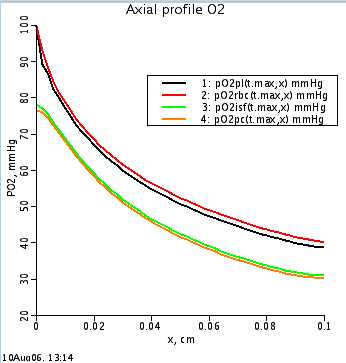Four region, distributed model for the O2-CO2 transport, exchange and metabolism.
Description
A detailed nonlinear four-region (red blood cell, plasma, interstitial fluid, and parenchymal cell) axially distributed convection-diffusion-permeation-reaction-binding computational model is developed to study the simultaneous transport and exchange of oxygen (O2) and carbon dioxide (CO2) in the blood-tissue exchange system of an organ. Since the pH variation in blood and tissue influences the transport and exchange of O2 and CO2 (Bohr and Haldane effects), and since most CO2 is transported as HCO3- (bicarbonate) via the CO2 hydration (buffering) reaction, the transport and exchange of HCO3- and H+ are also simulated along with that of O2 and CO2. Furthermore, the model accounts for the competitive nonlinear binding of O2 and CO2 with the hemoglobin inside the red blood cells (nonlinear O2-CO2 interactions, Bohr and Haldane effects), and myoglobin-facilitated transport of O2 inside the parenchymal cells. The consumption of O2 through cytochrome-C oxidase reaction inside the parenchymal cells is based on Michaelis-Menten kinetics. The corresponding production of CO2 is determined by respiratory quotient (RQ), depending on the relative consumption of carbohydrate, protein, and fat. The model gives a physiologically realistic description of O2 transport and metabolism in the microcirculation of the organ. Furthermore, because model solutions for tracer transients and steady states can be computed highly efficiently, this model may be the preferred vehicle for routine data analysis where repetitive solutions and parameter optimization are required, as is the case in PET imaging for estimating myocardial O2 consumption.

Above figure:
Axial concentration of Oxygen in the four tissue regions (pl = capillary, rbc = red blood cells, isf = interstital, pc = parenchymal)
Equations
The equations for this model may be viewed by running the JSim model applet and clicking on the Source tab at the bottom left of JSim's Run Time graphical user interface. The equations are written in JSim's Mathematical Modeling Language (MML). See the Introduction to MML and the MML Reference Manual. Additional documentation for MML can be found by using the search option at the Physiome home page.
- Download JSim model MML code (text):
- Download translated SBML version of model (if available):
- No SBML translation currently available.
- Information on SBML conversion in JSim
We welcome comments and feedback for this model. Please use the button below to send comments:
Dash, R.K. and Bassingwaighte, J.B., Simultaneous Blood-Tissue Exchange of Oxygen, Carbon Dioxide, Bicarbonate, and Hydrogen Ion, Ann Biomed Eng 34(7): 1129-1148 2006.
Dash RK and Bassingthwaighte JB. Erratum to: Blood HbO2 and HbCO2 dissociation curves at varied O2, CO2, pH, 2,3-DPG and Temperature Levels. Ann Biomed Eng 38(4): 1683-1701, 2010.
Please cite https://www.imagwiki.nibib.nih.gov/physiome in any publication for which this software is used and send one reprint to the address given below:
The National Simulation Resource, Director J. B. Bassingthwaighte, Department of Bioengineering, University of Washington, Seattle WA 98195-5061.
Model development and archiving support at https://www.imagwiki.nibib.nih.gov/physiome provided by the following grants: NIH U01HL122199 Analyzing the Cardiac Power Grid, 09/15/2015 - 05/31/2020, NIH/NIBIB BE08407 Software Integration, JSim and SBW 6/1/09-5/31/13; NIH/NHLBI T15 HL88516-01 Modeling for Heart, Lung and Blood: From Cell to Organ, 4/1/07-3/31/11; NSF BES-0506477 Adaptive Multi-Scale Model Simulation, 8/15/05-7/31/08; NIH/NHLBI R01 HL073598 Core 3: 3D Imaging and Computer Modeling of the Respiratory Tract, 9/1/04-8/31/09; as well as prior support from NIH/NCRR P41 RR01243 Simulation Resource in Circulatory Mass Transport and Exchange, 12/1/1980-11/30/01 and NIH/NIBIB R01 EB001973 JSim: A Simulation Analysis Platform, 3/1/02-2/28/07.

